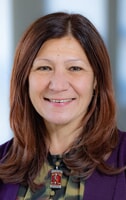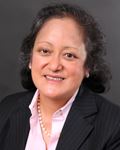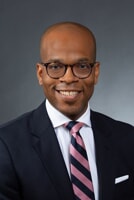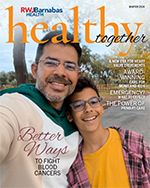“I knew I had to get moving so I could get out of the hospital and attend my son’s wedding.”

A heart transplant saves a man’s life—and helps him fulfill a dream.
Charles Upshaw was determined to make it to the wedding of his youngest son, Chase. But the 67-year-old retired Newark police officer and married father of three adult children had been waiting for a heart transplant for three years—and time was running out.
Charles, who lives in West Orange with Lisa, his wife of 29 years, had suffered from cardiomyopathy—a disease of the heart muscle that makes it difficult for the heart to pump blood— for more than five years before going into heart failure.

In 2020, the heart failure treatment and transplant team at Newark Beth Israel Medical Center (NBI), led by Claudia Gidea, MD, FACC, Medical Director of Heart Transplant, Mechanical Circulatory Support and Advanced Heart Failure, placed him on the heart transplant waiting list.
It was an important milestone in a process that dated to 2014, when Charles went to his primary care physician for his annual physical. “He detected an anomaly in my EKG,” Charles recalls. “That’s when it all started.”
A Long, Winding Road
A visit to a cardiologist in 2014 revealed the nature of Charles’ heart problem. “I had an issue with palpitations,” he says. Despite being prescribed the medication metoprolol to help regulate his heartbeat, palpitations became more frequent, with a heart monitor measuring 1,200 skipped beats in 24 hours.
Having open heart surgery to replace a heart valve helped—for a while. “It carried me for about four years,” he recalls. “But then I started having shortness of breath on exertion, so they implanted a pacemaker defibrillator.”
It was becoming increasingly clear that Charles’ heart was failing. He was referred to NBI’s Advanced Heart Failure Treatment and Transplant Program, where the evaluation and selection process is rigorous, comprehensive and focused on patients’ needs.
“We look at everything from head to toe—every single organ system,” says Margarita Camacho, MD, Surgical Director of Cardiac Transplant, Northern Division, RWJBarnabas Health. “We do a whole battery of tests that includes blood tests; imaging tests such as an echocardiogram, a CT scan of the entire body and vascular studies to make sure there is no peripheral artery disease or carotid disease; and a nutritional profile.”

In addition, meetings of a multidisciplinary selection committee are held to convene a variety of physician specialists—including heart failure cardiologists, cardiac anesthesiologists, cardiac intensivists and transplant surgeons—together with transplant coordinators, social workers, metabolic specialists, nurses and more.
“Charles was evaluated by our selection committee, and, in my role as program director, I accepted him,” says Dr. Gidea.
After a patient is put on NBI’s transplant list, the list is submitted to the United Network for Organ Sharing, which handles organ transplants across the United States. “They merge our list into the larger waiting list,” says Dr. Camacho.
On a status scale of 1 to 6, with 1 being the sickest, Charles was initially listed as a 6, in part because he otherwise had a history of robust health and regular exercise. “Because I was in such good physical condition, my body was able to compensate for what my heart couldn’t do,” he says, “which is why I remained a status 6 for almost three years.”
Waiting Game
But by fall 2022, Charles’ heart was functioning at less than 12 percent. Matthew Montgomery, DO, MBA, MPH, an advanced heart failure and transplant cardiologist on the NBI team, advised Charles that he should be in the hospital, where he could be closely monitored.

DO, MPH, MBA
“His symptoms continued to worsen, and he was finally admitted on January 18,” says Dr. Montgomery. “His status was upgraded to a 4—and then to a 2.”
Charles was now in end-stage heart failure. If a donor heart didn’t come through in a matter of weeks, he might not survive. In the intensive care unit under the transplant team’s vigilant care, he thought about Lisa, Chase and the wedding. He waited and prayed, more resolved than ever to make it.
At last, on the evening of February 8, the call came: A donor heart appropriate for his size and blood type had been located. The following day, Dr. Camacho performed a successful transplant. “Three days after surgery, I was up and out of bed,” says Charles. “I knew I had to get moving so I could get out of the hospital and attend my son’s wedding.”
Discharged 10 days after his transplant, Charles quickly got fitted for a tuxedo. Just 23 days after the surgery, on March 4, he and Lisa watched then-27-year-old Chase and his fiancee, Daphne, become husband and wife at The Mill Lakeside Manor in Spring Lake Heights. “It was amazing,” says Charles. “My wife and I just looked at each other the way we always do when we see God’s work.”
Charles went through 36 sessions of cardiac rehabilitation and is now working out four or five days a week. “I’m getting stronger every day,” he says. “There’s nothing I can’t do.” He’s also now committed to being an advocate for organ donation. “I have not lost sight of the fact that someone had to lose their life to give me my life,” he says. “I’m extremely grateful.”
Learn more about heart transplants at RWJBarnabas Health or request an appointment.
 View full issues of Healthy Together magazine by New Jersey region:
View full issues of Healthy Together magazine by New Jersey region: